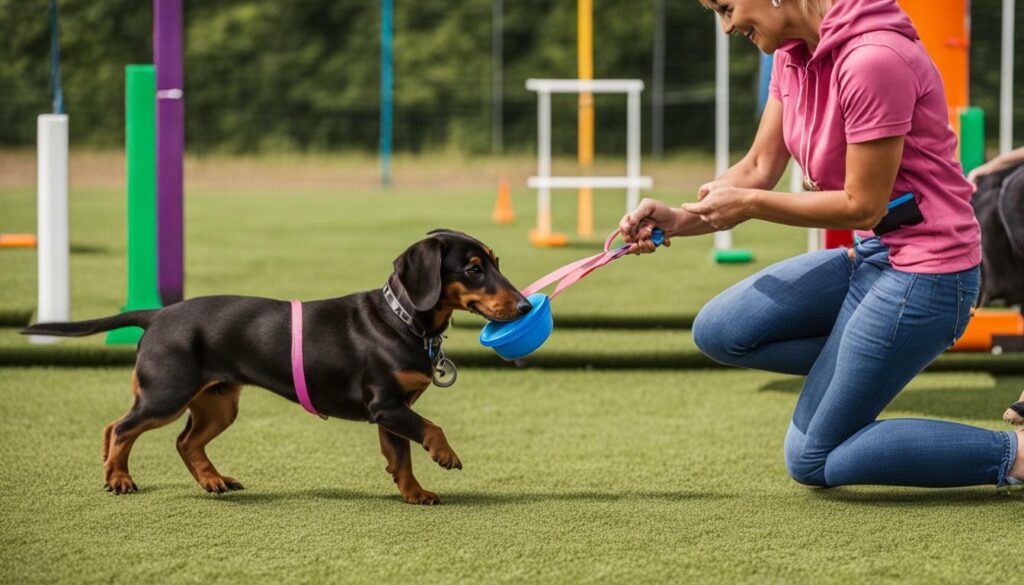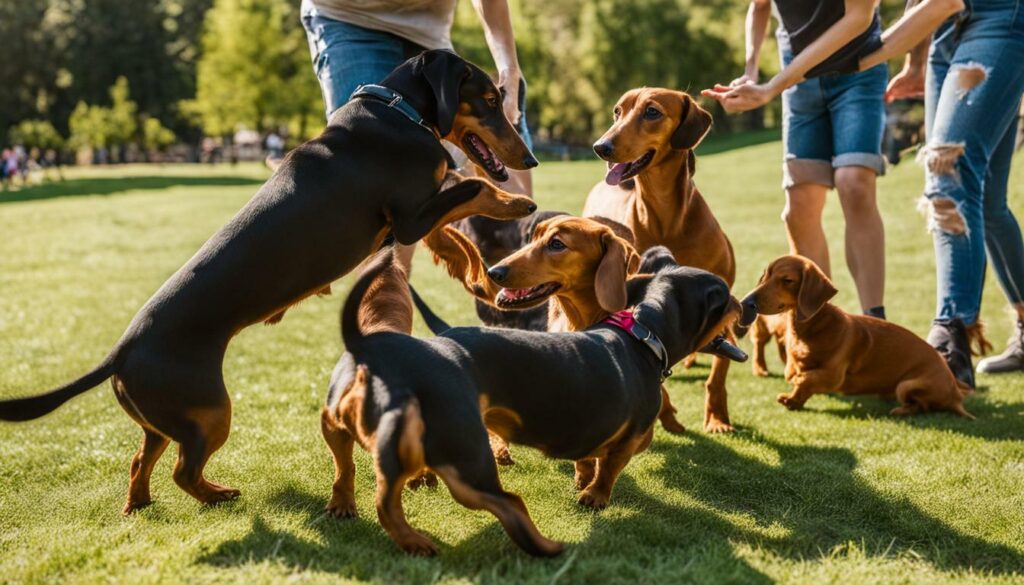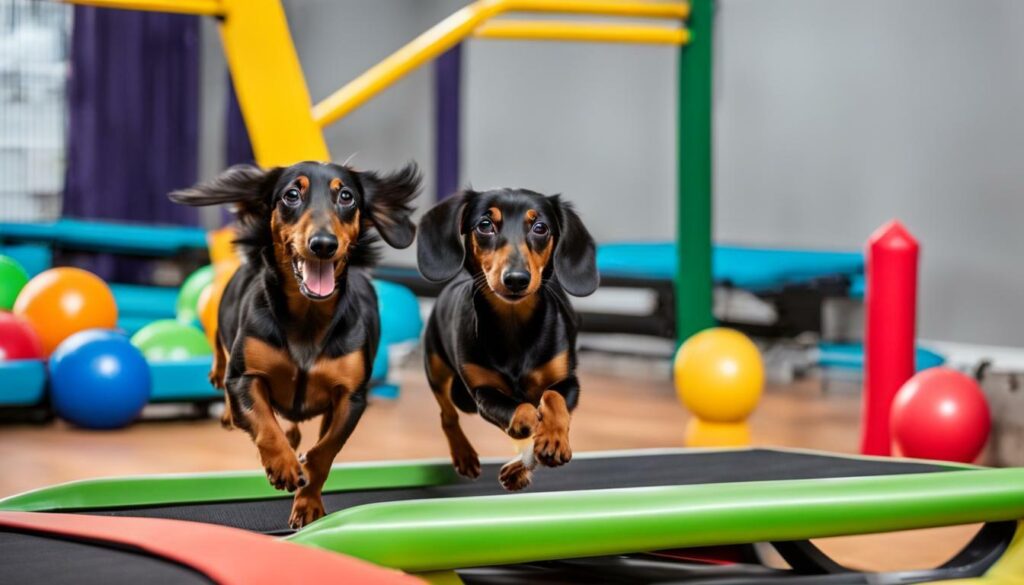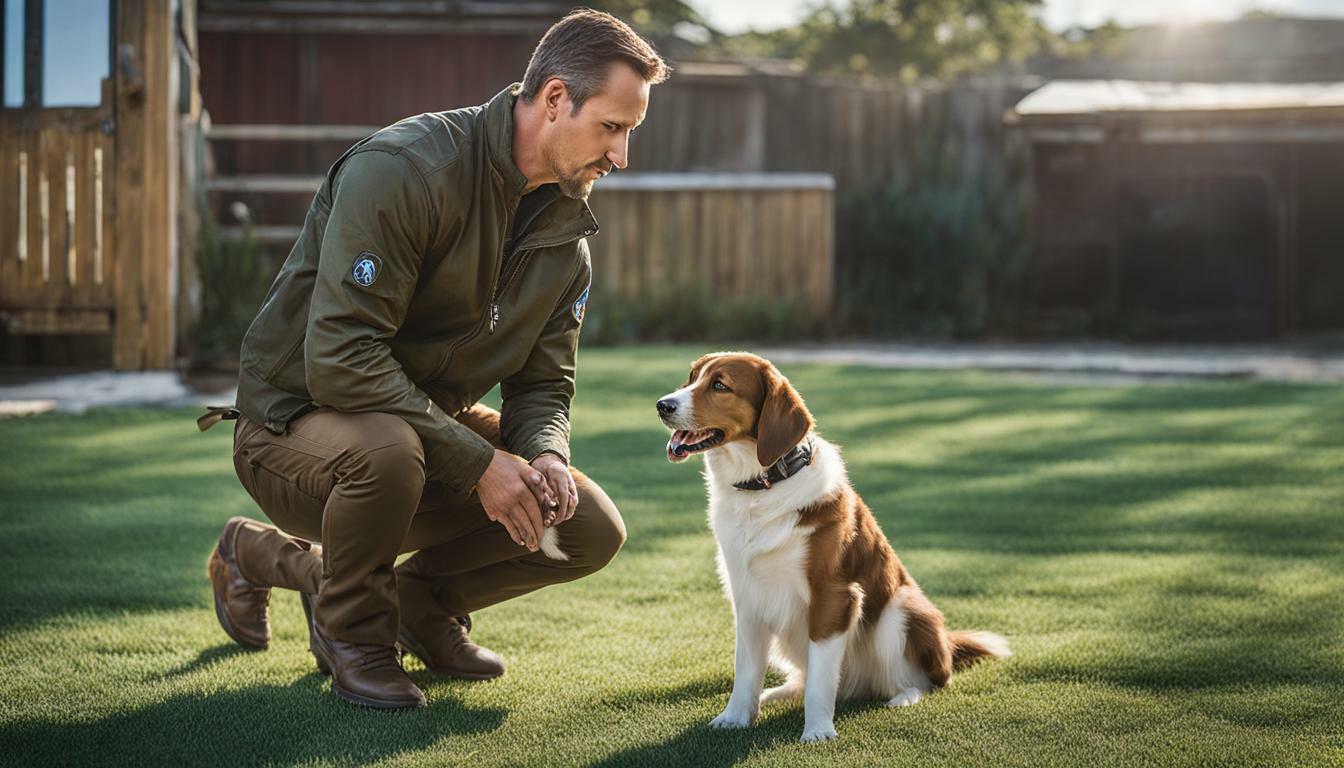Welcome to our comprehensive Dachshund ownership guide, where we provide expert advice on caring for your beloved Dachshund. Dachshunds are cute, lively, and affectionate dogs. However, they also come with unique challenges and needs that require attention and care. Being a Dachshund parent can be an enriching experience filled with joy and love, but it also requires dedication and commitment to ensure your furry friend leads a healthy and happy life.
In this guide, we cover all aspects of Dachshund ownership, from understanding the breed and providing proper care to training techniques and creating a safe environment for your pet. We also delve into Dachshund health, behavior, nutrition, grooming, exercise needs, and socialization.
- Being a Dachshund parent requires dedication and commitment to ensure your furry friend leads a healthy and happy life.
- Our comprehensive guide covers all aspects of Dachshund ownership, from understanding the breed and providing proper care to training techniques and creating a safe environment for your pet.
- We also delve into Dachshund health, behavior, nutrition, grooming, exercise needs, and socialization, which all play significant roles in ensuring your pet’s well-being.
- By following the advice in this guide, you can establish a strong bond with your Dachshund and enjoy a fulfilling and rewarding relationship with your furry companion.
- Remember that each Dachshund is unique, and while this guide provides comprehensive information, always consult with your veterinarian for personalized advice on your pet’s specific needs.
Understanding the Dachshund Breed
The Dachshund breed is known for its distinctive long, low-slung body shape, which is a product of their origins as hunting dogs bred to track badgers and other burrowing animals.
There are three varieties of Dachshunds: smooth-haired, wire-haired, and long-haired. Each variety has its unique characteristics and traits, but all Dachshunds share some common features. They typically weigh between 11 and 32 pounds and stand six to nine inches tall at the shoulder. Their lifespan ranges from 12 to 16 years.
Dachshunds have a reputation for being loyal, affectionate, and independent dogs. They can be stubborn at times but are intelligent and trainable with the right approach. They are also known for their playful and spirited personalities.
If you’re considering a Dachshund as a pet, it’s essential to research and understand the breed’s characteristics and needs. Dachshunds thrive in a home with a consistent routine and a lot of attention from their owners. They are sensitive dogs, so it’s crucial to create a nurturing environment and avoid harsh training methods.
Overall, Dachshunds are unique, fun-loving, and devoted pets that make excellent companions. With the right care, training, and attention, your Dachshund can live a long, happy, and healthy life.

As a responsible Dachshund owner, it’s essential to provide appropriate care for your furry friend. Proper care involves several key aspects, including maintaining their health, grooming, exercise, and nutrition.
Dachshund Health
Maintaining your Dachshund’s health is crucial to their overall well-being. Regular vet check-ups and vaccinations are essential to prevent illnesses and detect any potential health concerns early on. Keep an eye out for signs of potential health problems, such as changes in appetite, behavior, or energy levels.
In addition to regular vet visits, providing a safe and healthy environment for your Dachshund is vital. Ensure that your home is free of hazards, such as small objects or toxic substances that can harm your Dachshund.
Dachshund Grooming Tips
Grooming is an essential aspect of Dachshund care, not only for their appearance but also for their hygiene and overall health. Regular grooming sessions involve brushing, nail trimming, bathing, and teeth cleaning.
Brushing your Dachshund’s coat helps distribute natural oils, prevent matting and tangling, and remove any loose fur. Nail trimming is critical to prevent overgrown nails that can cause discomfort or even lead to infections. Bathing your Dachshund helps keep their coat clean, while teeth cleaning can prevent dental problems and bad breath.

Dachshunds may have short legs, but they still require regular exercise to stay healthy and mentally stimulated. Daily walks and playtime are essential, as well as opportunities for socialization with other dogs. Keep in mind that Dachshunds have a high prey drive and should always be supervised when outside or around small animals.
Dachshund Nutrition
Choosing the right food and providing a balanced diet is crucial for your Dachshund’s overall health. Ensure that their food is appropriate for their age, size, and activity level. Portion control is also critical to prevent obesity, which can lead to several health problems. Consult with your vet to identify any specific dietary considerations for your Dachshund.
By providing proper Dachshund care, you can ensure that your furry friend stays healthy, happy, and lives a long and fulfilling life.
Dachshund Training Techniques
Dachshunds are intelligent and independent dogs, making them both a pleasure and a challenge to train. When it comes to Dachshund training, it’s essential to use positive reinforcement techniques that establish trust and cooperation between you and your furry friend.
Start with Basic Obedience: Begin your Dachshund’s training by teaching them basic obedience commands such as “sit,” “stay,” and “come.” Keep training sessions short and frequent, making the experience fun and engaging for your Dachshund.
Be Consistent: Consistency is key when it comes to Dachshund training. Utilize the same commands and techniques every time you train to avoid confusion and reinforce good behavior.
Address Problem Behaviors: Dachshunds can display stubborn behaviors, such as digging, barking, and chewing. To manage these behaviors, it’s essential to redirect your Dachshund’s attention to something more appropriate and rewarding good behavior with praise and treats.
Positive Reinforcement Techniques
Positive reinforcement training is a respectful and effective way to train your Dachshund, encouraging good behavior through rewards and praise rather than punishment. In addition to basic obedience training, this technique can be used to address specific behaviors, such as leash pulling or barking. When using positive reinforcement, it’s essential to:
- Provide treats or other rewards immediately after your Dachshund displays good behavior.
- Use clear and consistent verbal cues to reinforce the desired behavior.
- Avoid using physical punishment or negative reinforcement, as this can damage your Dachshund’s trust and bond with you.
Remember, training your Dachshund takes patience and dedication, but the rewards of a well-trained and obedient companion are well worth the effort.

Dachshunds are popular for their unique traits and quirks, but their behavior can also be challenging for inexperienced owners. Understanding the motivations behind your Dachshund’s behavior is crucial to develop a harmonious relationship with them. Here are some key behavioral insights you should know:
Territorial Nature
Dachshunds are known for their strong territorial instincts. They may become possessive of their belongings and space, often exhibiting aggressive behavior towards other pets or unfamiliar people. Early socialization and positive reinforcement training can help mitigate this behavior.
Socialization Needs
Due to their territorial nature, Dachshunds require proper socialization from an early age to become comfortable around new people and animals. Socialization can prevent aggressive behavior and promote positive interactions in different environments.
Separation Anxiety
Dachshunds bond closely with their owners and may experience separation anxiety when left alone for extended periods. Separation anxiety can manifest in destructive behavior, excessive barking, and other stress-induced behaviors. Training techniques, such as crate training, can help ease separation anxiety.
Training Challenges
Dachshunds are intelligent and eager to please, but they can also be stubborn and independent. Basic obedience training can be challenging, but using positive reinforcement techniques can help build a strong bond with your Dachshund and motivate them to learn.
By understanding your Dachshund’s behavior, you can provide them with a nurturing environment and build a strong bond with them. In the next section, we’ll explore how to socialize your Dachshund and prevent potential behavior problems.

Dachshunds are social animals that require proper socialization to avoid behavioral problems. Early socialization can help prevent aggressive behavior towards people and other animals and ensure that your Dachshund feels comfortable and confident in various social settings.
Introducing Your Dachshund to New Environments
Exposure to new environments is essential for your Dachshund’s social development. Introduce your Dachshund to new places, sounds, and smells gradually. Start with short trips to pet-friendly places such as parks and cafes, and gradually increase the length of your outings. When socializing your Dachshund, always pay attention to their body language, and allow them to approach new situations at their own pace.
Socializing Your Dachshund with Other Dogs
Socializing your Dachshund with other dogs is essential to prevent aggressive behavior towards other animals. Start with controlled introductions in a neutral environment, such as a park, and observe your Dachshund’s behavior closely. Gradually increase the length of playtime and the number of dogs present. Remember to praise your Dachshund for good behavior and correct any negative behavior promptly.
Preventing Separation Anxiety
Dachshunds are prone to separation anxiety and may become destructive or vocal when left alone. To prevent separation anxiety, gradually accustom your Dachshund to being left alone for short periods. Provide them with interactive toys and puzzles to keep them mentally stimulated, and avoid making a fuss when leaving or arriving home.

Dachshunds respond well to positive reinforcement training techniques. Teach your Dachshund basic obedience commands, such as sit, stay, and come, and address any behavioral issues promptly. When training your Dachshund, use positive reinforcement, such as treats and praise, to reward good behavior, and avoid punishment-based training methods.
Conclusion
Proper socialization is crucial for your Dachshund’s emotional well-being and ensures a happy and harmonious relationship between you and your furry companion. By following the tips outlined in this guide, you can help your Dachshund become a confident and well-behaved member of your family.
Maintaining Dachshund Health
As a responsible Dachshund parent, maintaining your furry friend’s health should be a top priority.
Regular vet visits are crucial to ensure your Dachshund’s overall well-being. Be sure to schedule annual check-ups and vaccinations, as well as emergency visits when necessary. Since Dachshunds are prone to back problems, it’s essential to monitor their weight and avoid activities that put undue stress on their backs.
Look out for common health issues in Dachshunds, including joint and dental problems, obesity, and allergies. If you notice any unusual symptoms or changes in behavior, consult your veterinarian as soon as possible.
Providing your Dachshund with a healthy diet is also a key aspect of their overall health. Choose high-quality dog food and feed them according to their size, age, and activity level. Avoid giving human foods that may be toxic to dogs, such as chocolate, grapes, and onions.
Regular exercise is also important for your Dachshund’s health, both physically and mentally. Besides daily walks, consider engaging them in activities that cater to their energy levels, such as playing fetch or participating in agility training. Mental stimulation is also essential for preventing boredom and anxiety in Dachshunds.
By taking proactive steps to maintain your Dachshund’s health, you’re ensuring that they enjoy a happy and fulfilling life.

Feeding your Dachshund a balanced and nutritious diet is essential for their overall health and well-being. Dachshunds require a diet that provides them with all the necessary nutrients, vitamins, and minerals to maintain their body weight, energy levels, and keep their coat shiny and healthy.
One of the primary dietary considerations for Dachshunds is their tendency to become overweight due to their love of food and lack of exercise. Obesity can lead to various health problems, including joint pain, diabetes, and heart disease.
To ensure your Dachshund maintains a healthy weight, it’s essential to control their portion sizes and avoid feeding them table scraps or unhealthy treats. Instead, opt for high-quality dog food that meets their nutritional needs and is appropriate for their age and life stage.
Dachshunds have a unique body structure that requires them to maintain strong bones and joints. Foods rich in calcium and phosphorus, such as fish, poultry, and organ meats, can help support their skeletal system. Additionally, including foods high in omega-3 fatty acids, like salmon and flaxseed, can promote healthy bones and joints and reduce inflammation.
Dental health is also crucial for Dachshunds, who are prone to dental problems. Providing them with dry dog food or hard kibble rather than soft food can help prevent dental issues. Additionally, regular teeth cleaning and providing them with dental chews and toys can help maintain their dental health.
As with any breed, it’s essential to consult with your veterinarian to determine your Dachshund’s specific nutritional needs. Each dog’s diet may vary based on their activity level, age, weight, and overall health. A balanced diet can help support your Dachshund’s health and happiness, and enhance the bond between you and your furry companion.

Dachshunds are energetic dogs that require regular exercise to maintain their physical and mental well-being. Their short legs may seem like a hindrance, but they can still enjoy various physical activities with proper supervision. It’s essential to understand your Dachshund’s energy levels and tailor their exercise routine to their needs.
The following are some tips to ensure your Dachshund receives adequate exercise:
| Exercise Type | Frequency | Description |
|---|---|---|
| Walks | Daily | Short walks or long strolls are an excellent way to keep your Dachshund physically active while also bonding with them. |
| Indoor Activities | Regularly | Interactive toys, puzzles, and indoor games can help keep your Dachshund mentally stimulated, especially during inclement weather. |
| Swimming | Occasionally | Dachshunds can enjoy a swim, but it’s essential to supervise them in the water and gradually introduce them to the activity. |
| Playtime with Other Dogs | Occasionally | Dachshunds can be social creatures and enjoy playing with other dogs, but it’s essential to introduce them slowly and monitor their interactions. |
It’s crucial to avoid over-exercising your Dachshund, which can strain their delicate backs. Always monitor your Dachshund for signs of exhaustion, such as heavy panting or difficulty breathing, and adjust their exercise routine accordingly.

Remember: Providing regular exercise and mental stimulation is crucial to maintain your Dachshund’s overall health and happiness. Consult with your veterinarian for personalized advice on your Dachshund’s exercise needs, especially if they have any health conditions or are older.
Dachshund Grooming Tips
Dachshunds have a unique coat that requires regular grooming to keep it healthy and shiny. Here are some essential grooming tips to maintain your Dachshund’s coat and overall hygiene:
Brushing Techniques
Regular brushing is crucial for Dachshunds to prevent matting and maintain a healthy coat. Use a soft-bristled brush and start at the head, working your way down to the tail. Be gentle, as Dachshunds have sensitive skin. Brush in the direction of the hair growth to prevent discomfort. Brushing your Dachshund’s teeth is also important to maintain their dental health.
Nail Trimming
Trimming your Dachshund’s nails regularly is essential to prevent discomfort or injury. If you hear clicking sounds when your Dachshund walks on hard surfaces, it’s time for a trim. Use a sharp, pet-specific nail clipper, and avoid cutting the quick (the pink part of the nail that contains blood vessels). If you’re not comfortable trimming your Dachshund’s nails, consult a veterinarian or professional groomer.
Bathing and Drying
Dachshunds only need baths every few months unless they get into something messy. Use a mild shampoo, and avoid getting water in their ears. After bathing, dry your Dachshund thoroughly and keep them warm to prevent chills. Use a towel or blow dryer on a low heat setting to dry their coat gently.

Regular ear cleaning prevents ear infections, which can be common in Dachshunds. Use a cotton ball or pad and a gentle ear-cleaning solution recommended by your veterinarian. Stay away from cotton swabs, which can damage the ear canal.
Professional Grooming
While you can groom your Dachshund at home, professional grooming services can provide more specialized care. They can also trim your Dachshund’s coat in a variety of styles, such as a “puppy cut” or a “lion cut,” which can be a fun way to change up your Dachshund’s look.
By following these grooming tips, you can keep your Dachshund looking and feeling their best!
Creating a Safe Environment for Your Dachshund
As a responsible Dachshund owner, it’s crucial to provide a safe environment for your furry friend. Here are some tips to ensure your home and surroundings are secure for your Dachshund:
| Hazard | Solution |
|---|---|
| Small objects or toys | Keep small items out of reach to prevent choking hazards. |
| Chemicals and cleaning products | Store these products securely and out of reach of your Dachshund. |
| Electrical cords and outlets | Tuck cords out of sight or use cord protectors to prevent chewing. Cover outlets with childproof covers. |
| Other pets or animals | Supervise interactions between your Dachshund and other animals. Be cautious when introducing your Dachshund to new pets and seek professional help if necessary. |
| Open windows or doors | Ensure all windows and doors are securely closed or screened to prevent your Dachshund from escaping or falling out. |
By being aware of potential hazards and taking safety measures, you can create a secure environment that minimizes the risk of accidents, injuries, or escapes.

Congratulations on embarking on this incredible journey as a Dachshund parent! By now, you should have a good understanding of the care, training, and behavior needs of Dachshunds. Remember that each Dachshund is unique, and your bond with your furry friend will continue to strengthen as you navigate the joys and challenges of Dachshund ownership.
This Dachshund ownership guide is a valuable resource that you can refer to whenever you have questions or need advice. Use it as a starting point, but don’t hesitate to reach out to your vet or a professional trainer for personalized guidance.
As a Dachshund parent, it’s your responsibility to provide your furry companion with a safe, loving, and nurturing environment. Stay up to date on your Dachshund’s health needs, ensure they receive proper nutrition and exercise, and give them plenty of affection and attention.
Remember that being a Dachshund parent is a journey filled with love, laughter, and companionship. Enjoy every moment with your furry friend, and cherish the memories you create together.
Thank you for reading this Dachshund ownership guide. We hope it has been helpful in your journey as a Dachshund parent!
FAQ
Q: What will this Dachshund ownership guide cover?
A: This comprehensive guide will provide expert advice on caring for your Dachshund, including training tips, health and behavior advice, grooming techniques, exercise needs, nutrition, and more.
Q: What should I know about the Dachshund breed?
A: Before bringing a Dachshund into your home, it’s important to understand their characteristics, temperament, and specific needs. Learn about their history, different varieties, and typical traits to ensure a harmonious relationship.
Q: How can I provide proper care for my Dachshund?
A: Discover key aspects of providing optimal care, including maintaining their health through regular check-ups and vaccinations, grooming techniques, exercise requirements, and proper nutrition.
Q: What training techniques are effective for Dachshunds?
A: Dachshunds can be intelligent but stubborn. Explore effective training techniques tailored to the breed, from basic obedience commands to addressing common behavioral issues using positive reinforcement.
Q: What should I know about Dachshund behavior?
A: Dachshunds have unique behavior patterns and instincts. Gain insights into their territorial nature, socialization needs, separation anxiety, and more to create a nurturing environment for their emotional well-being.
Q: How can I socialize my Dachshund?
A: Socialization is crucial for Dachshunds to develop into well-rounded, confident dogs. Learn how to introduce them to new environments, people, and other animals to prevent behavioral problems and promote harmonious interactions.
Q: How can I maintain my Dachshund’s health?
A: This guide provides comprehensive information on maintaining your Dachshund’s health, including common issues to watch out for, preventive measures, regular vet visits, and recognizing signs of potential health problems.
Q: What diet should I feed my Dachshund?
A: Nutrition plays a vital role in your Dachshund’s well-being. Discover their specific dietary needs, including portion control, choosing the right food, and considerations for different life stages to ensure optimal health.
Q: How much exercise do Dachshunds need?
A: Despite their short legs, Dachshunds require regular exercise and mental stimulation. Learn about suitable exercise routines, activities to match their energy levels, and ways to keep them physically active and mentally engaged.
Q: How should I groom my Dachshund?
A: Proper grooming is crucial for your Dachshund’s coat and hygiene. Discover the best practices, including brushing techniques, nail trimming, teeth cleaning, and other tips to keep them looking and feeling their best.
Q: How can I create a safe environment for my Dachshund?
A: Learn how to make your home and surroundings safe for your Dachshund by puppy-proofing and identifying common household hazards. Create a secure environment that minimizes potential risks for your beloved furry friend.
Q: What should I remember as a Dachshund parent?
A: Congratulations on your journey as a Dachshund parent! Reflect on the valuable information and advice throughout this guide. Remember that each Dachshund is unique, and your bond with them will continue to grow as you navigate the joys and challenges of ownership.

Marissa Delotta, 36, from Dayton, Ohio, is the creative force behind Roverboard.com, a beloved online destination for dog lovers. As a dedicated mom and canine enthusiast, Marissa combines her family experiences with her love for dogs to offer a platform where dog owners can exchange tips, heartwarming stories, and advice. Her website has become a vibrant community for sharing the joys of dog parenting. In her free time, Marissa enjoys exploring dog parks with her family and volunteering at local animal shelters.





